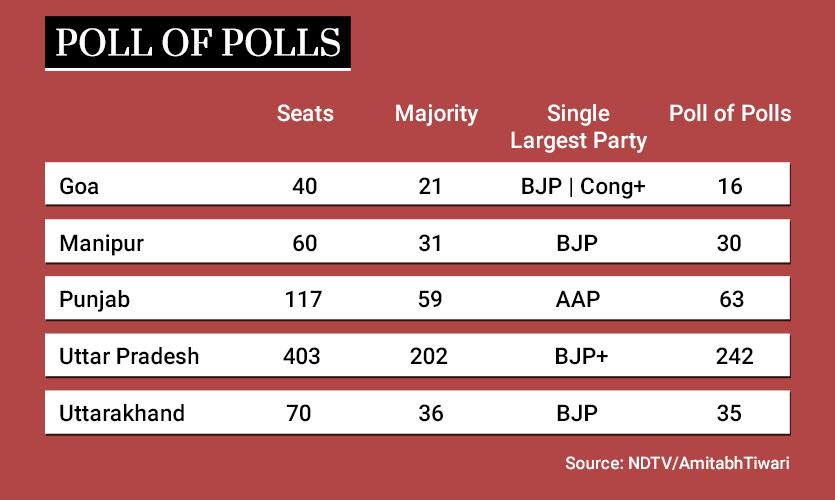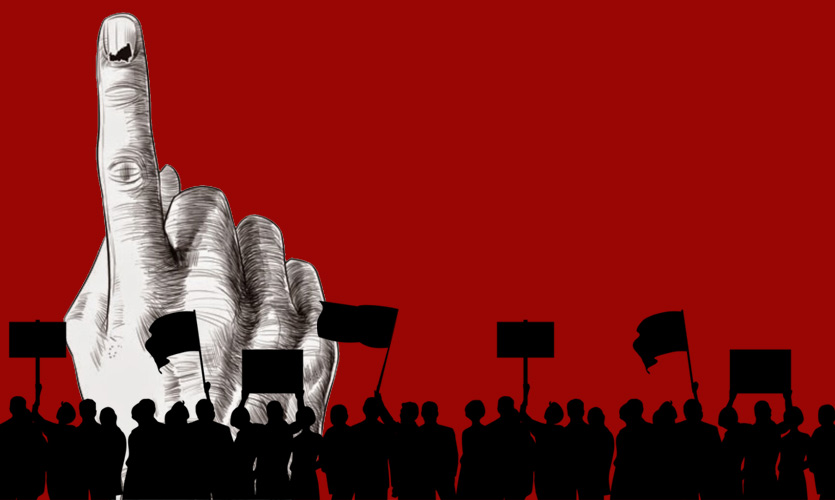Following the last phase of election in Uttar Pradesh on March 8, TV and phone screens have been flooded with exit polls, their predictions, and various inferences drawn from them.
Today’s counting will decide the fate of five states. So, what can we expect?

Goa and Uttarakhand
Election results in these states have always been unpredictable. According to most polls, the Bharatiya Janata Party (BJP) seems to have a slim chance at racing ahead of the Congress in Uttarakhand, with the poll of polls predicting a 35-seat win, one seat short of a majority. Parties in Uttarakhand usually fall prey to anti-incumbency, not coming back for a consecutive term. However, the prediction of a close contest and a voter turnout of 65.4 percent, similar to the 65.6 percent in 2017, could help set things in the BJP’s favour.
In Goa, a hung assembly is likely as most polls have predicted similar figures for both the Congress and the BJP, while the poll of polls has projected both parties to win 16 seats each. The BJP and the Aam Aadmi Party are contesting all 40 seats in the state. The All-India Trinamool Congress (TMC), Shiv Sena, and the Nationalist Congress Party (NCP) are also contesting in the Goa election. Alliances with regional parties in the state could prove decisive in forming a government. The Congress has tied-up with the Goa Forward Party, while the TMC has an alliance with the Maharashtrawadi Gomantak Party. It is possible that the TMC alliance could play kingmaker for the Congress faction, however, there are three other regional parties – the Revolutionary Goans, Goencho Swabhimaan Party and the Jai Mahabharat Party – and 68 candidates that have contested the Goa election as independents, leaving much room for speculation.
Manipur
BJP is the only party contesting on all 60 seats, which increases the probability of its re-election. The poll of polls puts the number of seats in the BJP’s account at 30, one short of the 31-seat majority mark. It could prove to be a comfortable victory for the party if it aligns with regional parties such as the National People’s Party or the National People’s Front, like last time. Political strategist and commentator Amitabh Tiwari explains, “The Congress is not fighting on as many seats. Moreover, people are not unhappy with the BJP in Manipur. Even though there is a little disappointment regarding the Armed Forces Special Powers Act (AFSPA), 1958, there is no resentment because the fact is that violence has gone down considerably, and people can finally see the possibilities of development.”
Interestingly, the armed conglomerate of the Kuki National Organisation (KNO) issued a diktat ahead of the election in Manipur that voters must favour the BJP “in tribal interest”. “The central government and ruling BJP leadership have promised swift settlement of Kuki political aspirations… in line with the ongoing political dialogue between KNO and Government of India,” explained the KNO. The state government and Union Home Minister Amit Shah have played a significant role in establishing a peaceful mode of dialogue with fringe groups in “disturbed” areas, with the Centre signing a Suspension of Operation with the KNO. “We will talk to all Kuki organisations, and a new life will be given to all Kuki youths to enable them to join the development of the nation, of the hills and of Manipur under PM Modi,” HM Shah reportedly said during an election rally in Manipur.
Punjab
Polls have predicted an overwhelming win for the AAP for the first time in a state, with the poll of polls showing it winning with 63 seats. Some polls have predicted that the party will win more than 70 seats, with Today’s Chanakya estimating a 100-seat win. However, it remains to be seen whether the sentiment of change translates into votes. Tiwari says, “AAP is still a volunteer party, and does not have as many grassroots and booth level workers. Punjab has also had the lowest voter turnout in 15 years, which is generally a sign of pro-incumbency. Although there can be exceptions if people desperately want a change.”
Talking about the main parties that have made their marks in Punjab in previous years, Tiwari says, “It is almost as if the parties have a vendetta against AAP. It is a regional party, and hence, a threat to the SAD (Shiromani Akali Dal). AAP has also emerged as a challenger against the national parties, and the Congress is rightly afraid that it will cut into its vote. The BJP, as an organisation, usually thinks about 15-20 years down the road. The AAP is a problem that could manifest itself on a larger scale for the BJP, and it is one they may like to nip in the bud. So, the Congress, BJP and Akali Dal will do everything in their power to not let AAP come through, including transferring seats.”
Estimating the AAP’s chances despite this, Tiwari says, “It ultimately comes down to vote share. The Congress won 70 seats on about a 39 percent vote share in 2017. Likely the AAP needs only about 40-43 percent vote share to become the single largest party. This could also be a result of the sympathy votes it wins with other parties banding together.”
“There is also an undercurrent of pro-Khalistan sentiment with this sentiment of change in Punjab, which could prove dangerous in the imminent future,” he adds.
Uttar Pradesh
Exit polls for Uttar Pradesh show the BJP-led bloc coming back to power with a historic win. UP is another state where anti-incumbency is strong and the party in power does not usually return to it. Most polls show the BJP alliance winning with 238-258 seats, with the poll of polls estimating a 242-seat win. The majority mark in UP is 202. The Samajwadi Party (SP) is the second largest party with an estimate of 128-148 seats. “It is just too much gap for SP to cover. Unless the BJP’s vote share falls drastically, it is coming back in UP,” says Tiwari. He further explains, “The voter turnout has dropped in UP, because people are not voting for change. A drop in voter turnout is usually a sign of pro-incumbency because people are happy with what they have and don’t feel the need to vote.”
Asked if additional alliances with a larger party such as the Bahujan Samaj Party (BSP) or the Congress could help the Akhilesh Yadav-led SP, Tiwari says, “Congress barely has any standing left in the state. The BSP could align with the BJP but not with the SP. A BSP-SP alliance is only possible if he (Akhilesh) agrees to make Mayawati the CM for the initial one and a half, two years, which won’t happen. Even if it does, Mayawati won’t leave the chair after the tenure is completed and could very well align with the BJP. But these events would be extremely absurd and are highly unlikely to happen.”
Trends in exit polls suggest a divided Muslim and OBC vote. While about 19 percent of the Muslim vote has been divided into the BSP and SP, 41 percent of the OBC vote has been divided across the BJP, SP and BSP. Even if the SP leads in OBC support, the Non-Yadav OBC (NYOBC) vote is likely to remain with the BJP. The incumbent party’s alliance with the Nishad Party also ensures a clean sweep in the Nishad community. SP’s alliance with the Rashtriya Lok Dal (RLD) could have significant gains among the Jats, but the Jatav vote is likely to remain with the BSP and the Non-Jatav with the BJP. Additionally, the consolidated Hindu vote only has one place to go.
The farmer protest and the Lakhimpur Kheri incident was expected to impact the BJP’s chances in this election, along with the rise in unemployment during COVID. However, the sentiment seems as pro-Yogi as it was five years back. “People who don’t farm think that the farm bill is the most important issue for the farmers. People who are employed think that unemployment is the biggest issue for the unemployed. But they are more concerned about Shri Ram and there is nothing anyone can do about it,” explains Tiwari.
Law and order, and development seem to have stood out as deciding factors in UP. The issue of law and order seems to be Akhilesh Yadav’s Achilles’ heel. After exit polls were released on Tuesday evening, Yadav alleged mismanagement of electronic voting machines and SP party workers stopped a truck carrying EVMs meant for the training for polling officers in Varanasi, the parliamentary constituency of Prime Minister Narendra Modi. He tweeted in Hindi, “The news of an EVM being captured in Varanasi has sent a message to every assembly in Uttar Pradesh to be on the lookout. All SP-alliance candidates and supporters should be prepared with cameras to thwart any attempt to rig the vote-counting process. Become soldiers in the counting of votes to protect youth democracy and future!” Chief Election Officer Sushil Chandra refuted all allegations first thing on Wednesday, explaining that since the EVMs don’t have a frequency they cannot be hacked. But the damage seemed to be done. One of the SP supporters tweeted, “Only Mobile in hand is not enough. The workers should ready with bamboos & sticks.”
The road to Delhi undoubtedly goes through Uttar Pradesh. UP sends 80 members to the Lok Sabha, and this state election is therefore, indicative of the public mood to be expected in 2024, kyunki dilli abhi dur nahi.
The Horus Eye is a weekly column written by Divya Bhan analysing current affairs and policies. This column does not intend or aim to promote any ideology and does not reflect the official position of The Sparrow.
Also read: Does The BJP Stand To Gain From Building Temples In The 2022 UP Election?










